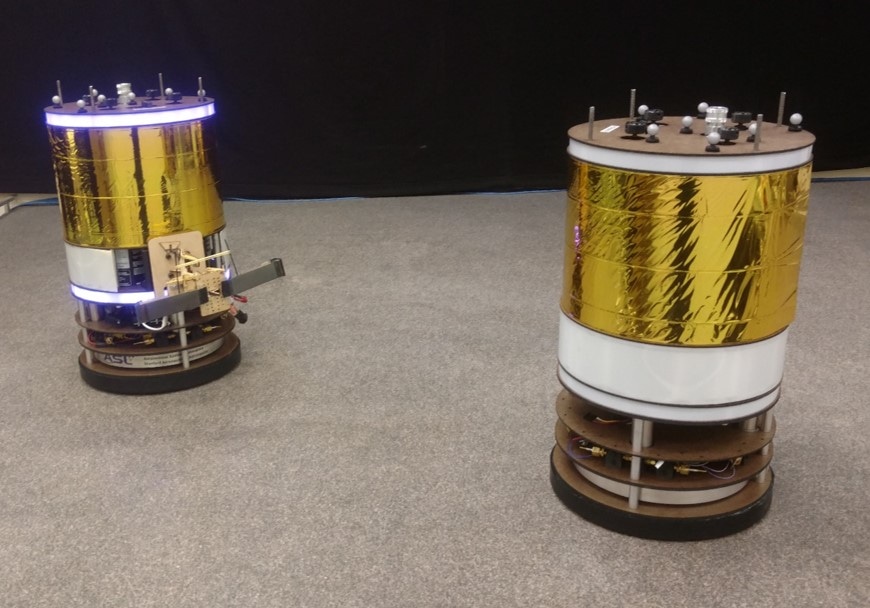Jun 19 2017
The key to making fleets of self-driving cars and grocery delivery by drones might be found in an unlikely source: autonomous space robots.
 Robots equipped with grippers designed for use on Earth could grab objects in space.(Image credit: Pavone Lab)
Robots equipped with grippers designed for use on Earth could grab objects in space.(Image credit: Pavone Lab)
Technologies to help robots adapt to changing and unknown environments are being developed by Marco Pavone, an Assistant Professor of Aeronautics and Astronautics. Pavone worked in robotics at NASA’s Jet Propulsion Laboratory before coming to Stanford. He continues to maintain relationships with NASA centers besides collaborations with other departments at Stanford.
Pavone considers his work in Space and Earth technologies to be complementary, "In a sense, some robotics techniques that have been developed for autonomous cars can be very useful for spacecraft control," Pavone said. Similarly, the algorithms he and his Students develop to enable robots make assessments and decisions on their own, within fractions of a second, could improve self-driving cars and drones on Earth besides helping in space exploration.
Space dodgeball
In one of his projects, Pavone focuses on enabling robots navigate separately in order to bring space debris out of orbit, grasp speeding, spinning objects out of the vacuum of space and deliver tools to Astronauts.
There is indeed margin for error when objects are grabbed in space.Striking an object in space could make recovering it next to impossible.
In space when you approach an object, if you’re not super careful in grasping it at the moment you contact it, the object will float away from you.
Marco Pavone, an Assistant Professor of Aeronautics and Astronautics, Stanford
Pavone solved grasping problems by teaming up with Mark Cutkosky, a Professor of Mechanical Engineering, who has spent the last 10 years in perfecting gecko-inspired adhesives. The gecko grippers make room for a gentle approach and just a simple touch to “grasp” an object, allowing effortless capture and release of spinning, unwieldy space debris.
However, the delicate navigation needed for grasping in space is no easy task. “You have to operate in close proximity to other objects: spacecraft or debris or any object you might have in space,” Pavone said. “That requires advanced decision-making capabilities.” Pavone and his collaborators developed algorithms capable of allowing space robots to autonomously react to such variable conditions and then grab space objects with their gecko-grippers in an efficient manner. The resulting robot will be able to move and grab in real time, updating the decisions made by it at a rate of several thousand times a second.
That type of decision-making technology also proves to be useful for solving navigation issues with Earth-bound drones. “For these vehicles, navigating at high speed in proximity to buildings, people and other flying objects is hard to do,” stated graduate student Benoit Landry. He highlighted the presence of a delicate interplay between making decisions and environmental perception. “In this context, many aspects of decision making for autonomous spacecraft are directly relevant to drone control.”
Landry and Pavone are currently working on “perception-aware planning,” which enables drones to consider fast routes and also to observe their surroundings and better estimate where they are. Currently, this work is being extended to handle interactions with humans, a vital component in deploying autonomous systems such as self-driving cars and drones. Landry added that Pavone’s background at NASA is a fine complement to the academic work.
Free roaming robot
After a robot lands on a small solar system body just like an asteroid, additional challenges cone up. These environments have entirely different gravity than Earth.
If you were to drop an object from waist-height, it would take a couple of minutes to hit the ground.
Marco Pavone, an Assistant Professor of Aeronautics and Astronautics, Stanford
Ben Hockman, a Graduate Student in Pavone’s lab, works on a cubic robot known as Hedgehog in order to deal with low-gravity environments like asteroids. The robot traverses rugged, uneven and low-gravity terrains by hopping instead of driving like standard rovers. Pavone and Hockman eventually want Hedgehog to be capable of navigating or completing tasks without being openly told how to do it by a human positioned millions of miles away
The present Hedgehog robot has been designed for reduced gravity environments, however it could also be adapted for Earth, Hockman said. “It wouldn’t hop quite as far because we have more gravity, but it could be used to traverse more rugged terrain where wheeled robots can’t go.”
Hockman considers the research he is doing in collaboration with Pavone as core scientific exploration.
Science tries to answer the hard questions we don’t know the answers to, and exploration seeks to find whole new questions we don’t yet even know how to ask.
Ben Hockman, a Graduate Student, Pavone’s lab
Cutkosky is also a member of the Stanford Neurosciences Institute and Stanford Bio-X.
Trajectory Optimization for Dynamic Grasping in Space using Adhesive Grippers